Even if you are satisfied with the CPC value, consider the following 18 points to reduce further the high CPC of search-based PPC ad campaigns in Google Ads
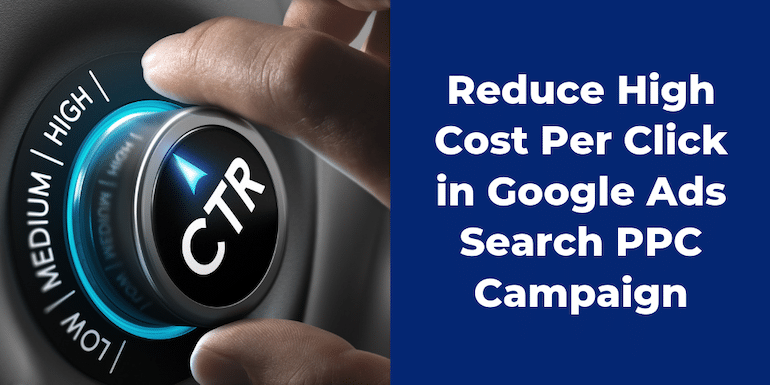
CPC or Cost per click is the amount an advertiser is willing to pay for each click on an ad for a keyword. So, once the advertiser is willing to pay, is it even possible to reduce the high CPC in Google Ads for the search based PPC campaigns?
The answer is YES.
Though you are willing to pay a much higher amount for each click, it doesn’t mean Google will charge the same amount.
Google Ads is a real-time bidding process. It means the price an advertiser will pay is determined based on the competition for the keyword and the relevance of the ad.
Let me share an example.
The first advertiser is willing to pay ₹7 per click or $0.10. The second advertiser is paying ₹3.5 per click or $0.05.
Now for the bidding, the amount to raise for each is 70 paise or $0.01.
Assume the first advertiser who is willing to pay higher, has a view and gets a click. The charge they will pay is ₹3.5+₹0.70 = ₹4.2 or $0.05+$0.01. It is one cent higher than the competition for the keyword. Of course with the assumption that all the other factors of the ad (Ad Copy, Quality Score, Relevance, etc.) for the keyword remains the same.
So now we know, it is possible to reduce the cost per click in Google search ads. Because it is not all about the price but other factors like Ad Copy, Quality Score, Ad Relevance, etc.
So here are 18 tips to help you reduce the cost per click in Google Ads for a search-based PPC campaign.
1. Bid for Phrase/Exact Match and Not Broad Match Keywords
Most of the time, people tend to be going for broad match keywords for a PPC campaign in Google Ads. Instead, they should always opt for a phrase match or exact match keywords.
Most people lose money in a Google Ads campaign on search terms that aren’t related to the business, yet keywords seem highly targeted.
Let me explain this with an example.
Let’s say I want to run a Google Ads PPC campaign for this same article. My keyword will be Reduce High CPC.
But when I use the keyword is a broad match, keywords like High CPC or CPC will trigger the ad.
Those search terms though being related, still may not drive the kind of traffic we want on this article.
So if I use the phrase match for the keyword Reduce High CPC, it means I target any keyword that has the same phrase of Reduce High CPC.
If not a phrase match keyword, I will include the keywords to have all the three terms in any order like “+reduce+high+cpc” in the search term.
Similarly, for long tail keywords, it is better to have an exact match as well.
Once you only have Phrase or Exact match keywords, the search terms triggering the ads will reduce. However, the users viewing and clicking the ads will be a highly relevant audience.
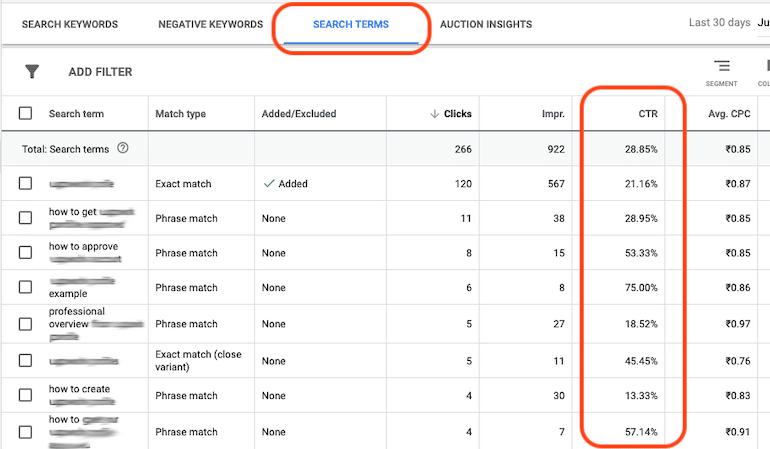
In the above screenshot, I have blurred the exact keyword. However, the search term as keyword drives a very high CTR. Other search terms where the exact phrase triggers the ads and generates excellent CTR.
Google is smart enough to add keywords that aren’t exactly a match but a close variant.
So if we go about by our example, “Reduce High CTR”, we may see “reduction in high CTR” as a close variant of an exact match as well.
The first step in lowering the cost per click in Google is to opt for the phrase or exact match keywords only.
2. Optimize Ad Groups for Small Set of Keywords and Highly Relevant Ads
Create separate ad groups for each product or service. Then add highly relevant keywords for each ad group along with highly targeted landing pages.
It leads to highly relevant ads. It will result in a high-quality score and a decrease in the cost per click.
So the way I like to have it is, I limit to only 2 to 3 keywords per ad group.

The keywords, the ads, and the landing page become highly relevant.
So it generates higher CTR for the ads, increasing the Quality Score, which ultimately reduces the CPC. On top of that, it produces a very high conversion rate.
A total win-win situation.
3. Don’t Increase the Bid for First Page/Position
The competition for the top spot will always be high.
Still, as we can see from the above screenshot, the traffic and CTR is decent for an average second position.
Moreover, for one keyword, as in the above screenshot, the CPC bid is way below the first-page bid estimate. Still, it is getting the impression and the clicks. CTR is excellent. So, over time, the quality score will increase and reach a 10/10 to reduce the price further.
So, I refrain from increasing the bid.
Again, it is not a rule to not increase the bid. At times, you may want to increase the bid to get high on the CTR and reduce the CPC bid as quality score improves with higher CTR.
So I will not say never increase the bid for the first page/position. However, more often than not, it should not need an increase.
Even when your bid is not enough to show an ad on the first page, it will show ads and get Impressions on search partners. Make ad copy interesting enough to drive clicks. Google will increase the quality score to reduce the price for the first-page bid.
4. Get the Quality Score of At least 7 or Above
Everything for Google Ads revolves around the quality score.
When a user performs a search in Google, whatever he enters in the search box is the search term.
Depending on how related the search term is for the keywords in your ad account, an ad may trigger a display to the user.
From this point onwards, everything depends on the quality score.
How relevant is the ad to the user’s search term will determine the quality score of the keyword?
Initially, Google will assign a quality score of 5 to 7 out of 10 for keywords depending on the relevance of the ad to the keywords.
TIP: Once you have a very diverse set of keywords and ads with an ad group, the quality score can have an impact on the negative side. So it is recommended to have a low number of keywords and ads within a group.
As the ads are shown, depending on the CTR of the ad for the search term as well as the competition, the quality score improves and inches above 7.
As the quality score improves, the cost per click reduces drastically.
If you don’t see the quality score improving despite higher CTR for a keyword, it can mean the landing page may need some adjustments. So, include the keywords or the search terms or add the content from the ad copy to the page.
5. Switch to Manual CPC
There are many bidding options in Google Ads currently, and over time, Google will add a few more as well.
The one that works best for me has always been the manual bidding or as they call it now Manual CPC.
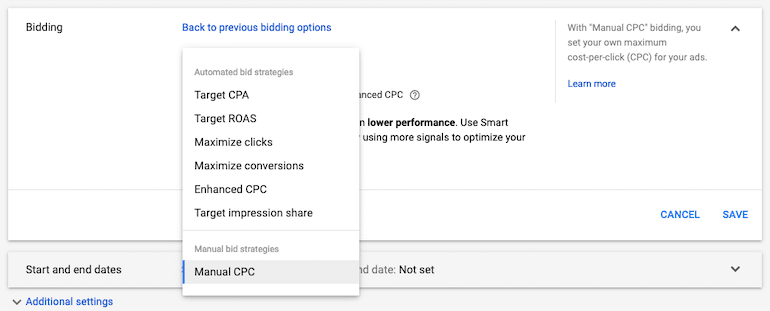
If you aren’t sure if Manual CPC is right for you, the next one to choose is to Maximize clicks or Maximize Conversions.
The secret is, to have more control over your ads than to let Google decide on them for you.
With Manual CPC, you as an advertiser is in control of how much you pay for a click for a particular keyword.
6. Adjust CPC for the Right Devices
How is the user interaction for the landing page on mobile, tablets, and computers for the campaign?
Is there a scope of reduction in price for devices that aren’t driving clicks or conversions?

On mobiles and tablets, I have often seen a higher CTR. With the increase in CTR, even if you lower the per click value, Google will not stop sending traffic.
Keep an eye on the devices report. Look for an opportunity to lower the bids.
7. Add Negative Keywords
No matter how laser focus your set of keywords are, you don’t want to be showing ads for some search terms.
Add them as negative keywords.
The ads won’t show for those terms increasing the overall CTR of the ad group, thus reducing the CPC.
Note: Now we only have an option to add negative keywords at ad groups level only.
Like keywords, one can even use negative keywords as a broad, phrase, or an exact match.
8. Different Campaign for Different GEO or Reduce the CPC Bid For Certain GEO’s
The CPC amount varies considerably for countries.
The cost per click in India may not be the same as in the US or in Bangladesh.
Having a single campaign with all the GEO can mean for a low-cost GEO location, they end up in the first position/page, making it a lot more costly.
Having a different campaign that targets the right GEO location can help reduce the CPC considerably.
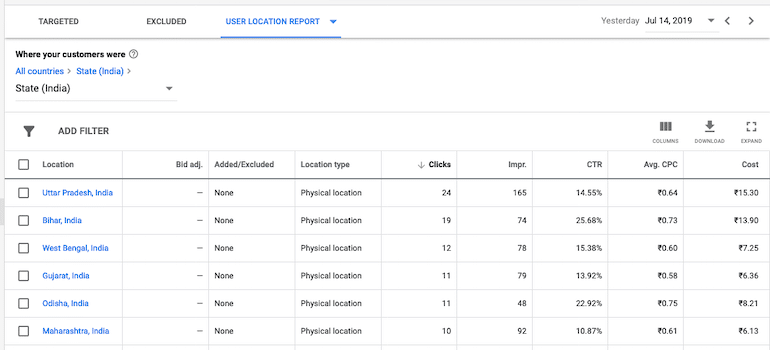
However, even within a country, there are opportunities to reduce the CPC by adjusting a lesser amount for an individual state, country, or even a city.
Opportunities are endless if one is willing to dig deep.
9. Include Search Partners
Sites that use Google search to power their site search are known as search partners or search network.

It is always a good idea to include them in the search based PPC campaign.
With manual bidding and keeping the bid on the lower side, often I see the ads do not appear on Google search initially.
They start with Google’s search partner sites.
As ads and keywords are related, they drive CTR, which increases the quality score. Ultimately the ads start to show on Google search results as well.
I am of the view, instead of having a higher CPC to show on Google search results to drive CTR, it is a wiser option to go with the search network route. As the quality score improves with CTR, Google starts showing ads on Google search more often.
10. Different Campaign for Search and Display Network
We are only focusing on the search based PPC campaign to reduce the CPC. However, I thought I would include the uber-important point to keep the search and display campaigns as separate.
Never include both displays and search in one single campaign.
The CTR for a display campaign will be a lot lower than a search campaign because, on the display network, the CTR is not only a factor of keywords and ad copy but the placement of ads as well.
One can argue Google is intelligent enough not to have a bad CTR impact search campaign, but as an advertiser, it can be tough to estimate the CTR of search and display ads accurately.
On top of that, having separate campaigns won’t create an issue.
So, as a rule, I always keep the search and display campaign separate.
11. Run Ads at The Right Time
Ad scheduling allows an advertiser to select day and time to run the ad.
Running an ad 24×7 may not always be better for good ROI or return on investment.
As an example, if you are targeting a campaign for a particular GEO, target the day time only and don’t run the ads when most of the people are sleeping.
Analyze time slots and days when your ads get a better response from viewers. Then schedule ads accordingly.
As a result, your ads can have more conversions because it is showing to a potential customer who is more likely to convert. It may not directly lower the CPC but definitely can help with higher conversion rates.
12. Discover Long Tail Keywords With Low Competition
16% and 20% of Google searches are such that they have never been searched before in Google. (Internet Live Stats)
Every 1 in 5 searches is new and unique.
Having longer keywords can help in lowering the CPC because the competition for them has to be low due to less search volume.
As an example, you want to advertise for “buy LED TV”. It is bound to have competition. How about changing the keywords to “buy 32 inches LED TV”. Quite a long keyword which reduces the competition to a large extent. As you add more to the keyword, the competition will reduce further like “buy best 32 inches LED TV”.
Long-tail keywords are not only part of the SEO but should be used in PPC as well when the competition is fierce for the main keywords.
When aiming for lower CPC, avoid highly competitive keywords.
13. Lower Bid Price for Keywords Based on ROI
In manual bidding, each ad group has a price, but each keyword can have a price as well.
So one can reduce the price for some keywords to see how the performance of the campaign changes.
Remember, when you make too many changes to an ongoing campaign, it will not result in any conclusive evidence of the experiment.
So when you want to lower the per keyword pricing, make sure you aren’t changing other parts of the campaign. Else you will not be able to know what changes cause to change in the performance of the campaign.
14. Optimize The Ad Copy (Headline + Descriptions)
If your ad copy connects with the audience for their query, you are bound to get a reasonable click-through rate.
There is no doubt about it.
Having multiple variations of the headlines and descriptions can help connect with the audience to boost the CTR of the ads.
Google is smart enough to show the one that gets the maximum clicks.
Moreover, ad copy with an apparent call to action works best.
If you want to make sales, having a buy now in the ad always works better than surprising the user with a buy now button on the landing page.
Similarly, if you are looking for leads and are offering something worth downloading in return for an email, Use the Download Now in the ad copy.
TIP: One can dynamically change the ad copy and insert the user search term. I don’t use it because I like to keep very related keywords as a phrase match in the ad group. So the ad includes the phrases making the search term part of the ad all the time.
Pro Tip: When I find that perfect ad copy, I change the meta description as well as the excerpt of the page with the performing ad copy. The reason being, it is the kind of content that drives click on the ad. So having the same as meta description and an excerpt will also drive clicks to the content organically as well.
15. Optimize the Landing Page
Optimization of a landing page doesn’t necessarily always mean the change in font or the button colors.
What I mean is, if you don’t see the quality score improving despite higher CTR for a keyword, it can mean the landing page may need some adjustments to include the keywords or the search terms on the page or even the ad copy content.
I use the ad copy that drives CTR as meta descriptions. If headlines of the ad copy don’t align with the title of the landing page, copy the ad headline to the title of the landing page.
Similarly, if the content doesn’t align with the ad copy or search terms, optimize the page content accordingly.
Get the exact phrases users to search from search terms and try to include them in the content.
16. A/B Test the Landing Page
Weather blue buttons make visitors subscribe more or the red button?
The real test is not about the color of the button, but the copy that drives the reader to use the button.
Neither blue nor red will be invisible to the user (unless you have such a design to get it hidden).
It is the content that makes the user use the button.
So when analyzing the A/B testing data, make sure the results are with a substantial amount of data. The mistake I see advertisers often make when testing is, they conclude the outcome way too early or test those things that don’t matter at all.
So focus on conversions and get the landing page to convert. If not for sales definitely for leads. Have an ROI for a business and then look upon it to better it.
17. Add Conversion Data to convert Campaigns to CPA
Conversion helps Google know your ads are working.
Google wants you to continue using Google Ads for a very long time.
So if you provide conversion data, Google prefers and suggests converting the campaign into CPA based ads. So you can continue to make sales at a reasonable cost all the time.
A complete win-win situation.
18. Add Sitelink Extension to Increase Overall CTR and Lower CPC
More ads will result in more CTR, which will increase the quality score for ads, ultimately driving the cost per clicks lower.
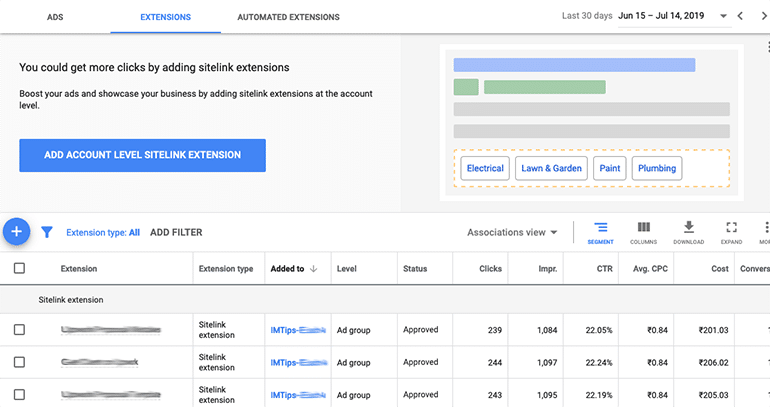
Again, those links do not end up on the landing page but other site pages. They aren’t very high on conversions, but help drives a lot more traffic to the site.
Finally: Why only Search Ads?
Search is not the only option. Display Network can also drive Good quality traffic to your site. It is all about conversion and the cost of conversion.
The display network isn’t too focus on keywords or quality score. It is the ad placement that becomes a major factor for the CTR.
